
Messier 61 is an intermediate barred spiral galaxy in the Virgo Cluster of galaxies. It was first discovered by Barnaba Oriani on May 5, 1779, six days before Charles Messier discovered the same galaxy. Messier had observed it on the same night as Oriani but had mistaken it for a comet. Its distance has been estimated to be 45.61 million light years from the Milky Way Galaxy. It is a member of the M61 Group of galaxies, which is a member of the Virgo II Groups, a series of galaxies and galaxy clusters strung out from the southern edge of the Virgo Supercluster.
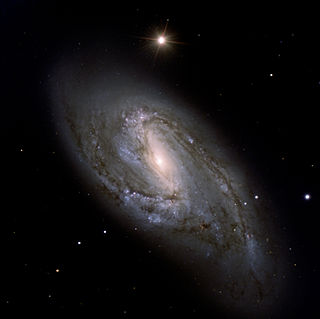
Messier 66 or M66, also known as NGC 3627, is an intermediate spiral galaxy in the southern, equatorial half of Leo. It was discovered by French astronomer Charles Messier on 1 March 1780, who described it as "very long and very faint". This galaxy is a member of a small group of galaxies that includes M65 and NGC 3628, known as the Leo Triplet or the M66 Group. M65 and M66 are a common object for amateur astronomic observation, being separated by only 20′.

NGC 1532, also known as Haley's Coronet, is an edge-on barred spiral galaxy located approximately 50 million light-years from the Solar System in the constellation Eridanus. The galaxy was discovered by James Dunlop on 29 October 1826.

NGC 4414 is an unbarred spiral galaxy about 62 million light-years away in the constellation Coma Berenices. It is a flocculent spiral galaxy, with short segments of spiral structure but without the dramatic well-defined spiral arms of a grand design spiral. Four supernovae have been observed in this galaxy: SN 1974G, SN 2013df, SN 2021J, and SN 2023hlf.

NGC 1559 is a barred spiral galaxy in the constellation Reticulum. It is also a Seyfert galaxy. Although it was originally thought to be a member of the Dorado Group, subsequent observations have shown that it is in fact not a member of any galaxy group or cluster and does not have any nearby companions. NGC 1559 has massive spiral arms and strong star formation. It contains a small bar which is oriented nearly east-west and spans 40″. Its bar and disc are the source of very strong radio emissions.

NGC 4088 is an intermediate spiral galaxy in the constellation Ursa Major. The galaxy forms a physical pair with NGC 4085, which is located 11′ away.

NGC 4945 (also known as Caldwell 83) is a barred spiral galaxy in the constellation Centaurus, visible near the star Xi Centauri. The galaxy was discovered by James Dunlop in 1826 and is thought to be similar to the Milky Way Galaxy, although X-ray observations show that NGC 4945 has an unusual energetic Seyfert 2 nucleus that might house a supermassive black hole. Around the nucleus of the galaxy, there is a dense disk of dust and gas, along with many dense star clusters. This object has an estimated mass of 1.4+1.4
−0.7×1011 M☉.

NGC 7479 is a barred spiral galaxy about 105 million light-years away in the constellation Pegasus. William Herschel discovered it in 1784. NGC 7479 is also recognized as a Seyfert galaxy and a LINER undergoing starburst activity not only on the nucleus and the outer arms, but also across the bar of the galaxy, where most of the stars were formed in the last 100 million years. Polarization studies of this galaxy indicate that it recently underwent a minor merger and that it is unique in the radio continuum, with arms opening in a direction opposite to the optical arms. This feature, along with the asymmetrical arms of the galaxy and the intense star formation activity are attributed to a merger with a smaller galaxy. This galaxy is similar in both size and morphology to the barred spiral NGC 1300.
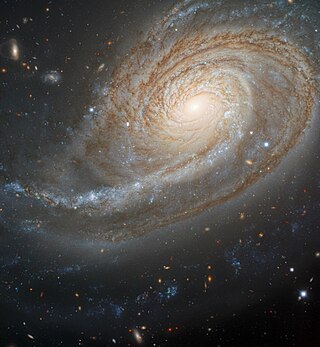
NGC 772 is an unbarred spiral galaxy approximately 130 million light-years away in the constellation Aries.
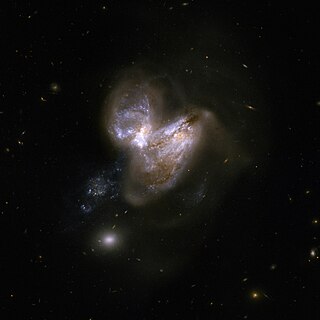
Arp 299 is a pair of colliding galaxies approximately 134 million light-years away in the constellation Ursa Major. Both of the galaxies involved in the collision are barred irregular galaxies.

NGC 5371 is a face-on spiral galaxy in the constellation Canes Venatici. NGC 5371 is a symmetrical face-on Sbc barred spiral galaxy at a distance of 100 million light years. This galaxy with Hickson Galaxy Group 68 makes up the Big Lick Galaxy Group.
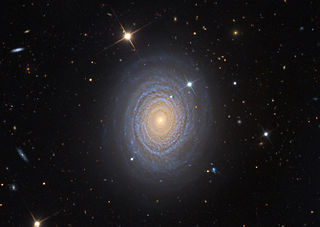
NGC 488 is a face-on spiral galaxy in the constellation Pisces. It is at a distance of about 90 million light-years away from Earth. Its diameter is estimated to be 52,6 Kpc. The galaxy has a large central bulge, and is considered a prototype galaxy with multiple spiral arms. Its arms are tightly wound. Star forming activity has been traced within the arms. The nucleus of NGC 488 has been found to be chemically decoupled, being twice as metal rich as the central bulge of the galaxy. NGC 488, with the exception of its smaller companions, that form NGC 488 group, is an isolated galaxy.
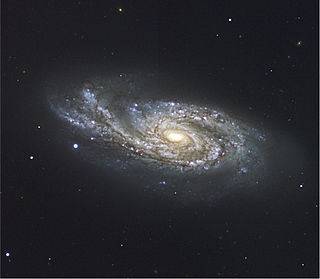
NGC 908 is an unbarred spiral galaxy in the constellation Cetus. It was discovered in 1786 by William Herschel. This galaxy is 56 million light years away from Earth. It is the main galaxy in the NGC 908 group, which also includes NGC 899, NGC 907, and IC 223.
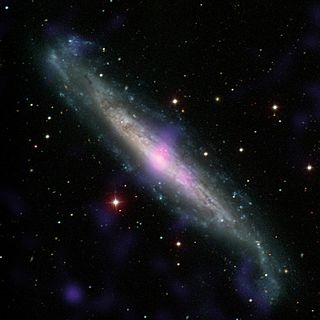
NGC 1448 or NGC 1457 is an unbarred spiral galaxy seen nearly edge-on in the constellation Horologium. It is at a distance of 55 million light years from Earth. It was discovered by John Herschel in 1835.
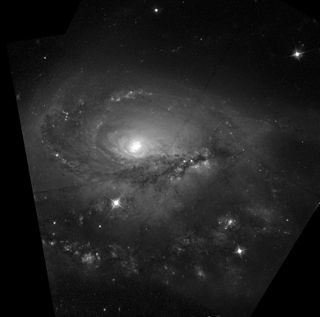
NGC 1961 is a spiral galaxy in the constellation Camelopardalis. It was discovered by William Herschel on 3 December 1788. It is at a distance of about 200 million light years from Earth, which, given its apparent dimensions, means that NGC 1961 is more than 220,000 light years across. The galaxy has been distorted, however no companion has been detected nor double nuclei that could show a recent merger. Its outer arms are highly irregular. Two long straight arms extent from the north side of the galaxy. A luminous X-ray corona has been detected around the galaxy. NGC 1961 is the central member of the small group of nine galaxies, the NGC 1961 group.
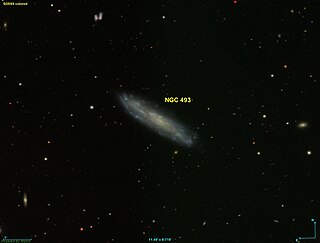
NGC 493, also occasionally referred to as PGC 4979 or GC 281, is a barred spiral galaxy in the constellation Cetus. It is located approximately 90 million light-years from Earth and was discovered on December 20, 1786 by astronomer William Herschel. It was later also observed by his son, John Herschel. John Dreyer, creator of the New General Catalogue, described the galaxy as "very faint, large, much extended 60°" with "a little brighter middle".
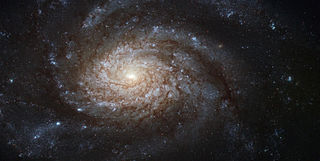
NGC 3810 is a spiral galaxy located in the constellation Leo. It is about 50 million light years from Earth, and estimated to be about 60,000 light years in diameter. William Herschel discovered it on 15 March 1784.

NGC 5468 is an intermediate spiral galaxy located in the constellation Virgo. It is located at a distance of about 140 million light-years from Earth, which, given its apparent dimensions, means that NGC 5468 is about 110,000 light-years across. It was discovered by William Herschel on March 5, 1785.
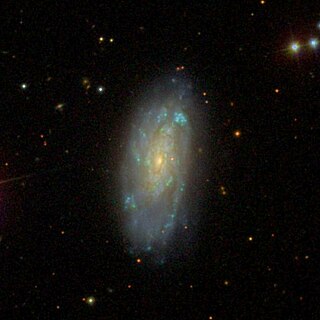
NGC 7448 is a spiral galaxy located in the constellation Pegasus. It is located at a distance of circa 80 million light years from Earth, which, given its apparent dimensions, means that NGC 7448 is about 60,000 light years across. It was discovered by William Herschel on October 16, 1784. It is included in the Atlas of Peculiar Galaxies in the category galaxies with detached segments.

NGC 4939 is a spiral galaxy located in the constellation Virgo. It is located at a distance of about 120 million light years from Earth, which, given its apparent dimensions, means that NGC 4939 is about 190,000 light years across. It was discovered by William Herschel on March 25, 1786.






















